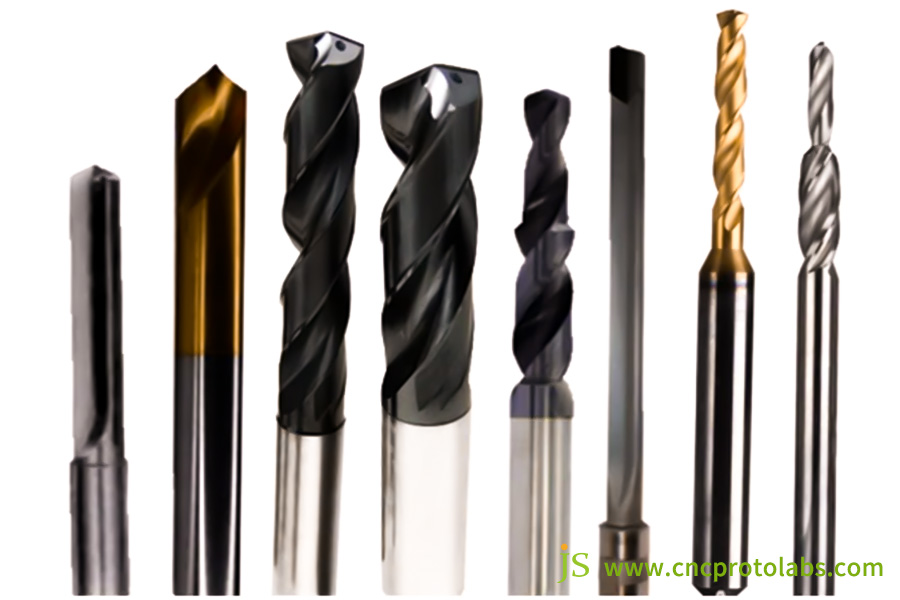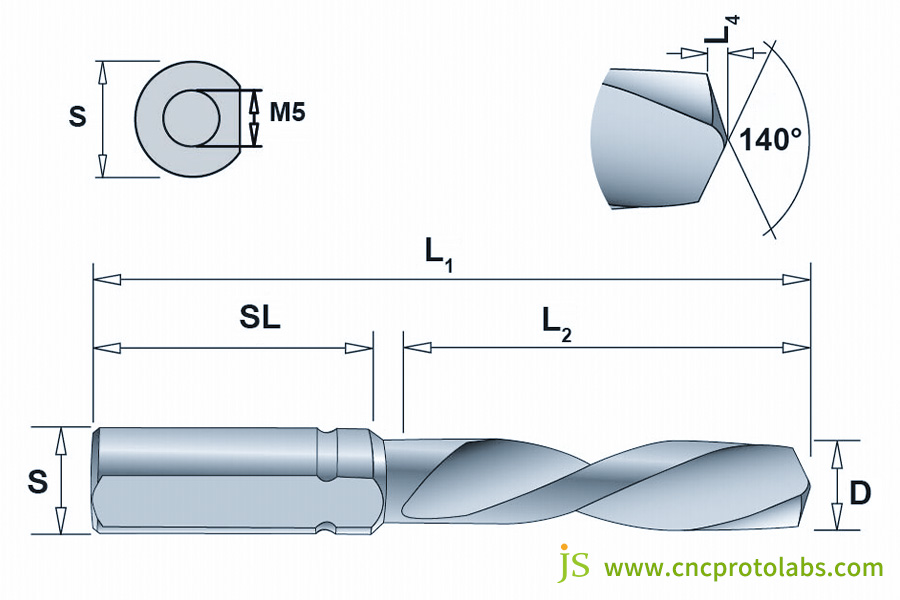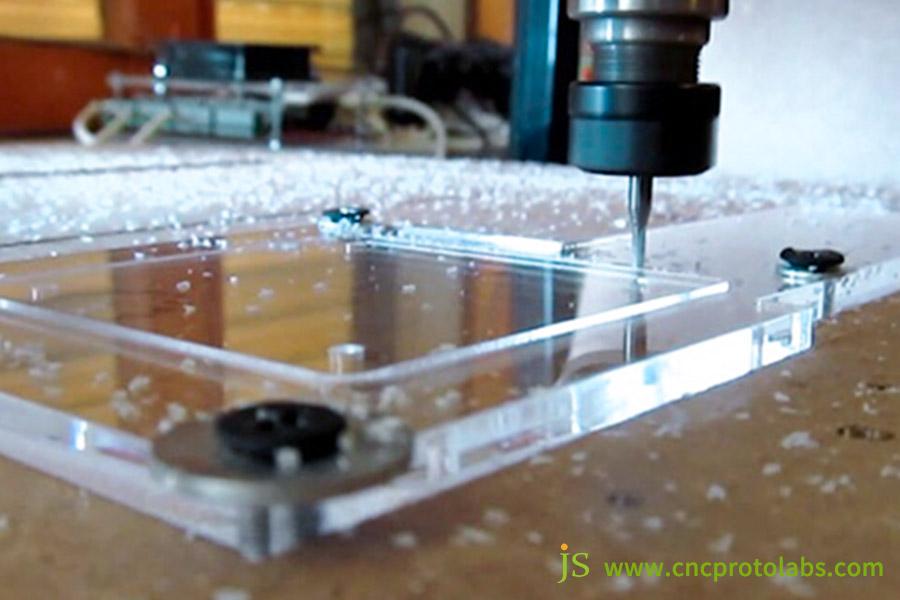A beautifully designed acrylic panel snaps in two with a crack when CNC drilling! Or the rims get welded together, with the walls of the hole spiderwebbed with cracks. We're all too familiar with this scene. Don't rush to blame the machine, it's just the wrong drill bit.
Acrylic, or acrylic acid, is a handy product: clear, shatter-resistant, lighter than glass, and less prone to shattering. It's used in everything from delicate medical components to lampshades and display screens. But it has two vulnerable characteristics: First, it's brittle and will crack. Second, it's low-melting, so it'll be sensitive to heat and melting during machining.
With a standard twist drill that is designed for cutting metal? That's a catastrophe! The inadequate design of the drill bit denies heat a means of escape, directing stress into the metal. Chipping, burning, and cracking follow, and scrap rates skyrocket.
Do you wish to create acrylic parts with sharp edges, even holes, and required durability? Success most times relies on the small CNC drill bit which you would choose. Success or failure in precision machining relies on the tip of the drill.
Core answer summary:
| Problem |
Best solution for
|
Absolutely avoid
|
|
Cracks at the edge of the borehole
|
Committed multi blade polishing drill bit (≥ 118 ° drill tip angle). |
Ordinary double blade Fried Dough Twists drill.
|
|
Hole wall melting/burrs
|
Compressed air cooling+high speed/low feed.
|
No coolant flushing.
|
|
Thin plate layering
|
Backboard support+progressive drilling strategy.
|
One time penetration drilling.
|
What You'll Get in This Article:
- Within this article, I would like to discuss four key issues when selecting a CNC drill bit, especially when working with acrylic.
- We will explain how to adjust process parameters such as speed, feed, and cooling.
- For example, consider the latest medical device panels we produced. We increased our yield rate from 65% to 98% after the upgrade of the drill bit, a huge improvement.
- We will also explore how to control costs by optimizing the CNC machining price and achieve high-quality output in custom CNC machining manufacturing.
Why Trust This Guide? JS's Acrylic CNC Machining Gene
I've been working at JS for nearly 20 years, acrylic processing. We've processed over 120 tons of acrylic and are very familiar with its behavior. Our workshop isn't your standard workshop, we maintain temperature and humidity even more rigorously than in a lab to ensure the consistent behavior of our acrylic panels.
Once there was an old client, making medical panels, who was completely freaked out. 500 panels were to be scrapped due to too rough hole walls (Ra 3.2μm). All because of incorrect drill bit selection. After it was in our hands, we replaced it right away with a specially manufactured polished drill bit and corrected the feed rate. Hole wall received mirror finish, roughness reduced to Ra 0.8μm.This not only saved the project, but also saved costs for the customer by optimizing the online CNC machining services process.
In order to succeed, you should sharpen your tools ahead of time. Our workshop is equipped with Haas five-axis machining center with a special head for acrylic capable of holding even the toughest angles.
"As quality management expert Crosby said: Quality is free; it's a gift that meets requirements."
We are ISO 9001 certified, and medical-grade cleanliness procedures are our standard every day! This experience and dedication are our pillar.

Core Principle: Why Does Acrylic Require A Specialized Drill Bit?
Acrylic is a strange material: It's first brittle and tends to crack under a lot of pressure. Second, it's heat-sensitive and becomes soft and mushy at around 160°C.
According to test data from JS, the glass transition temperature (Tg) of ordinary acrylic is broken at 160-165 ° C, leading to increased molecular chain movement and softening. This explains why standard metal drill bits are ineffective, as their cutting heat easily exceeds this threshold.
Standard metal drill bits will not do the trick here:
- The drill point is too sharp and too shallow in its angle. Drilling does not "cut" the material, but rather "pushes it in," and it will shatter under pressure.
- The chip-out slot is too small to permit the powder of drilling to get out. The perpetual friction inside causes it to get hot and melts and incinerates the hole walls. The crisp, beautiful finished product which is undoubtedly the ultimate target is impossible.This is crucial for high-precision CNC machining parts and the basis for controlling CNC machining prices.
Four Major Types of Acrylic Drill Bits
We produce specialized drill bits in an effort to specifically overcome the two inadequacies of acrylic:
- Increased drill point angle (≥118°): This reduces downward pressure on the drill, preventing the material from cracking and creating a smoother entry to the hole.
- 3-4 strip polished lands: The blade is very highly polished to a shine, scraping rather than tearing the hole wall. This creates a very smooth, glass-like finish, ideal for high-performance CNC machining parts.
- Extra-large chip flutes: These wide, shallow flutes eject formed powder right away, deterring frictional heat and secondary hole wall damage.
- Surface hard coating (e.g., gold or purple-black): Wear resistant and have slow thermal conductivity, preventing heat transfer to acrylic.
In custom CNC machining manufacturing, this drill bit can significantly improve the quality of CNC acrylic services.
Want holes in acrylic that won't crack, blur, or blur, and remain transparent and clear? Ordinary drill bits are not the answer. Acquiring the proper specialized drill bit is essential! Our JS drill bits are all about not being restricted by the limitations of acrylic machining. Need to machine high-precision acrylic components? Don't hesitate to call JS to discuss solutions!
A Complete Analysis Of Acrylic CNC Drill Bits
The choice of the right drill bit can make or break drilling into acrylic, especially where hole clarity is imperative, such as in display stands. Our suggestion is based on three main methods:
(1) The Ultimate Solution - Specialized Acrylic Drill Bits:
This is our top solution, especially when you want a hole as clear and transparent as glass. Its most notable characteristics are a more acute drill point angle (usually around 140°) and a mirror-finish blade.
What are the benefits?
Drilling lowers the pressure that is exerted to the material and thus minimizes the possibility of cracking or chipping. The mirror-finished blade "scrapes" the hole wall rather than "tears" it, producing an extremely smooth hole with superior light transmittance, complying with the highest visual standards. For world-class CNC acrylic service, this is the route to take.
(2) Affordable Substitute - PCB Flat-Bottom Drill Bit
If you are on a tight budget and employing thin boards (preferably no thicker than 3mm), such as for concealed mounting holes on the back of electronic panels, and you do not specifically need high-quality finishes, turn to this style of flat-bottom drill bit for employment when drilling PCBs.
Its biggest advantage is that it's inexpensive. But you get what you pay for. Drilled holes will not be as smooth as they would be with a specialist drill bit, and there will be a greater risk of developing little problems like minor chipping or whitening. The quality and stability in general will be much worse.In online CNC machining services, this can be used for low-cost prototyping.
(3) Absolute Don't - Use a Blunt Ordinary Twist Drill
This point must be emphasized: DO NOT USE! Every day twist drill bits used for metal drilling are a disaster to work with acrylic once their blades become blunt.
A blunt bit does not "cut" the material, it rather "grinds" and "squeezes" the material, creating immense force. Drilling acrylic with this type of blunt drill bit is nearly guaranteed to crack, with a near-100% chance! Being cheap on a drill bit and then having to scrap a piece or even an entire workpiece is wasteful.
Want to drill beautiful and even holes in acrylic? Utilize specialized drill bits. Remember, dull drill bits are a recipe for cracking, avoid them! Need to drill quality acrylic parts quickly? Talk to JS. We have the drill bits, and we know how.

Recommended Practice: Top 3 Acrylic CNC Drill Bit Brands And Parameters
As an engineer at JS who frequently works with acrylic, I can offer some practical drill bit selection and operating parameters based on my experience debugging equipment:
- Garant PF-POLY: This is one of the most commonly used drill bits in our workshop for drilling acrylic between 1 and 20mm thick. It performs remarkably well when drilling thin to medium thicknesses. I usually set the speed to around 6,000 rpm and keep the feed rate at approximately 0.05mm per revolution (the drill advances 0.05mm per revolution). This brand offers good value and is a practical choice for work. The unit price is above average.
- Kyocera ACOM Series: I would choose this when working with heavy material over 20mm or requiring a super high finish. Because of the thickness, the speed must be reduced, 4000 rpm is always a good bet. The secret is to use spiral pecking (drill a little, retract to remove chips, and drill again), or else the tool will stick and burn for sure. This company does a great job, and of course, the price is great.
- YG-1 X-PERT ACRY: Very handy when drilling very thin acrylic (0.5-5mm). Chip removal design is this drill. Always feed compressed air to the drill to aggressively clear chips; this is critical in making a smooth, crack-free hole. Dry cutting or poor coolant will result in a scrapped workpiece. Slightly more expensive than the Garant.
How to adjust the parameters? Remember this helpful tip:
- Speed (RPM): 3000 + (100 x hole diameter in mm). So for a 5mm hole, around 3500 rpm will be a good setting.
- Feed rate (mm/rev): Hole diameter (mm) x 0.01. For a 5mm hole, use 0.05mm/rev as feed rate.
- Cooling/chip removal: Compressed air works the best! But if not, atomized coolant can be used. Dry cutting is to be avoided wherever possible, as acrylic melts very easily.
Market performance of top worldwide brands as benchmark:
| Brand |
Garant
|
YG-1
|
Kyocera
|
|
Core advantage areas
|
Universal processing, cost-effectiveness.
|
Thin plate/special groove type.
|
High precision, difficult to machine materials.
|
|
Global market share (acrylic drill bits)
|
~32%
|
~22%
|
~18%
|
|
Customer satisfaction (processing quality)
|
85%
|
88%
|
92%
|
|
Typical unit price level (USD)
|
$25- $50 per unit
|
$40- $90 per unit
|
$80- $150/piece
|
|
Data sources
|
IMTS 2024, Seco Tools Market Analysis.
|
Gardner Business Media, Tool distribution data.
|
Internal customer research (Top 50 manufacturers), Kyocera annual report. |
Key Operational Tips:
Worry not just about feed rate and speed, chip evacuation is important too! Getting the compressed air hose and nozzle properly set up can make a world of difference. To do a great job, especially in custom cnc machining manufacturing, mind these aspects and your yield rate will automatically increase.
Choosing the right drill bit and parameters makes acrylic machining easy. With a Garant universal, Kyocera precision engraving, or YG-1 thin sheet metal tapping tool, combined with a few tips for adjusting your equipment and using compressed air effectively, you can easily handle the job. Have a challenging custom part? Contact our JS team anytime to discuss solutions!
Emergency Case Study: How The Cracked Hole Crisis Of 500 Acrylic Medical Panels Was Addressed
As one of the engineers involved directly in this emergency effort, my hands still sweat as I look back at those 48 hours.
This case has been included in the JS internal knowledge base.The customer's 500 medical panels were spiderweb-cracked at the edges, and they were about to become irretrievable.We found through root cause analysis (RCA) that the previous supplier neglected the strain rate sensitivity of acrylic, resulting in stress concentration under dynamic loads.
Using the wrong drill bit can be disastrous!
The client's previous supplier made a huge mistake in using a twist drill designed to drill iron on an acrylic. The angle was too sharp, and it was hot and brutal cutting. How could a brittle medium like acrylic tolerate this? Internal stress immediately flared, cracking all around the hole. Bluntly put, the material was torn and burnt.

How did JS clear the problem in a hurry? Three tricks won the victory!
(1) First: Change the drill bit in a hurry—a drill for acrylic!
Straight away dispose of the metal drill and replace it with our premium 140°, high-angle, mirror-edged drill bit. This drill boasts a smoother contact surface that slides in rather than wedge-shaped, reducing the splitting force dramatically. The mirror-edged cutting edge reduces friction and heat generation. This is paramount to ensuring the hole wall is smooth!
(2) Second: Layered drilling with real-time cooling—fine work to control risk!
When dealing with pre-existing broken acrylic, drilling straight through is suicidal. We do the step-by-step, layer-by-layer method, similar to an ant gnawing at a bone:
- We only drill 1mm deep per pass, fully removing the drill bit between layers. This gives the material a little air, so the inside tension developed from drilling can evaporate and won't build up to cracking levels.
- All this time, 0.6MPa compressed air is constantly concentrated on the drill point. This isn't regular air blowing to push out dust, it's tightly controlled temperature! We monitor the drill point in real-time so that it never exceeds 80°C, as excessive heat is the primary cause of secondary cracking.
(3) The third method: Online inspection and strict prevention—not one defective product gets through!
Even with tight deadlines, quality is paramount. After drilling every 10 holes, the machine automatically stops to inspect the hole's smoothness and dimensions. If the data shows even the slightest discrepancy, or any visible flaw, the board is immediately marked and removed from production by the system for separate processing. Defective parts are never allowed to enter the next process, ensuring that only good parts are delivered.

The results of the rescue: Not only on-time delivery, but also real money!
Through 48 hours of frenzied activity, all 500 panels were shipped as qualified! (Originally, 85% were expected to be scrapped.)
We saved the customer 35% overall cost! How did we achieve this cost savings?
- We saved astronomical shipping costs: We avoided the high cost of expedited air freight to meet the deadline.
- We saved the cost of material replacement: 500 acrylic panels don't cost nothing in themselves!
- We avoided rework inconvenience: We didn't have to hire new personnel or delay repairs.
- We saved exorbitant shipping costs: We didn't have to pay the extravagant cost of express air freight to meet the deadline.
- We saved our reputation: We met the deadline for delivery to our medical client, which is even more invaluable.
Cost comparison of emergency acrylic repair solutions:
|
Cost item
|
Traditional rework plan (estimated)
|
JS emergency intervention plan (actual)
|
Save amount (USD)
|
Notes |
|
Extra processing hours
|
$6,000
|
$4,200 |
$1,800
|
The JS solution is quite specific and must be run with accuracy, and the CNC machining price is slightly higher but the efficiency is high.
|
|
Material scrap/repurchase
|
$8,500
|
0
|
$8,500
|
Original 500 panel material costs. |
|
Customer default penalty risk
|
$10,000+
|
0
|
$10,000+
|
Estimated on contract-prescribed minimum penalty. |
|
Premium for expedited logistics
|
$3,500
|
$800 |
$10,000+
|
Scrap the international air freight and opt for expedited ground transportation instead. |
|
Total comprehensive cost
|
~$28,000
|
~$5,000
|
~$23000 (decreased by 82%)
|
Actually, saved 35% of the project value to the client.
|
Data Source: Modern Machine Shop 2024 Emergency Machining Cost Research Report & JS Internal Case Library
Core Experience:
This rescue was a combination of luck and technique, but it's preferable not to get to this point! The key to achieving precision holes in acrylic lies in three significant points: developing a dedicated tool library, perfecting the layered drilling parameter package, and online monitoring. Prevention of stress happening (right drill bit, temperature control, and layering) is ten thousand times cheaper and hassle-free compared to remedying afterward! Online CNC machining services, in particular, offer remote monitoring of these trouble spots.
Don't give up if your acrylic hole is cracked, properly understanding the three fundamentals of stress, temperature, and tooling will suffice. This wild rescue is proof of it. Have a difficult precision part to machine? Call JS. We're here 24/7 to save you money and deliver to meet!
FAQs
Q1: How are complex hole positions ensured?
For complex hole positions, our engineers will visit the drawings in person and ensure production involves using a chamfered drill bit with several blades. This specifically designed drill bit for acrylic prevents cracking around holes and yields a high-quality finish.
Q2: What makes JS's online cost estimator precise in estimating CNC machining cost?
The trick to our accurate online quotes is that we possess detailed data on various materials in the backend and automatically factor drill wear costs into consideration. You simply need to select the acrylic grade, say PMMA #8N, the thickness of the board, and the number of holes to be drilled, and the system will provide you with the processing cost instantly. This involves drill wear cost, which gives an exact quote.
Q3: Can a standard drill be used to drill acrylic at reduced speed?
We have found through real-world testing that using a regular drill bit at reduced speed to perform work on acrylic is ineffective. Slowing down will make the material more susceptible to breaking. An acrylic-specific drill bit, coupled with high speed, is required.
Q4: Is this solution suitable for small orders?
Small batches are no problem! That's our strength in custom CNC machining manufacturing. Even for one piece, we'll do it. Your machine's onboard library of small-sized drill bits automatically recognizes you with the appropriate tool, allowing accurate and reproducible production, saving you time and energy.
Summary
When machining acrylic parts like medical panels that require very high precision and safety, the traditional approach has a tendency to consider drill bits to be consumables to be used indiscriminately and replaced when they become damaged. We've discovered that this approach is hazardous and full of pitfalls! The art of producing a good hole and the ultimate success of a part is not in the price of the drill, but in how it's being used—the drill bit, cutting technique, and cooling technique—is the secret of our success.
Get started!
If you're producing or tooling acrylic parts and need to have your unique drilling parameters and cost immediately, send us your drawings or 3D models today! JS will get back to you immediately with two helpful services:
- Get your tailored parameter package instantly: We will quickly generate an "Acrylic Drilling Optimization Parameter Package" from your design. It precisely defines the recommended drill bit, number of layers to machine, cutting depth and rate (feed rate and speed) per layer, and cooling parameters. All valuable information tailored to your part. Follow these guidelines to avoid such errors as burrs and chipping.
- Transparent quotes, clear at a glance: We'll instantly calculate the CNC machining price for your part. We'll reveal the materials used, machining challenges, and tooling costs. You'll clearly see where your money is going, with no hidden costs.
→ Upload your drawing now! Lock in this customized process plan and precise quote for your part.
You've put so much effort into your design, it must have a perfect hole. Make the most of this "first drill" and JS's CNC acrylic service will help you turn your design into a reality!
We suggest that you immediately upload your design through online CNC machining services to obtain real-time CNC machining price estimates and DFM (Design for Manufacturing) reports based on AI algorithms, in order to avoid common pitfalls.
Disclaimer
The contents of this page are for informational purposes only.JS seriesThere are no representations or warranties, express or implied, as to the accuracy, completeness or validity of the information. It should not be inferred that a third-party supplier or manufacturer will provide performance parameters, geometric tolerances, specific design characteristics, material quality and type or workmanship through the Longsheng Network. It's the buyer's responsibilityRequire parts quotationIdentify specific requirements for these sections.Please contact us for more information.
JS Team
JS is an industry-leading companyFocus on custom manufacturing solutions. We have over 20 years of experience with over 5,000 customers, and we focus on high precisionCNC machining,Sheet metal manufacturing,3D printing,Injection molding,Metal stamping,and other one-stop manufacturing services.
Our factory is equipped with over 100 state-of-the-art 5-axis machining centers, ISO 9001:2015 certified. We provide fast, efficient and high-quality manufacturing solutions to customers in more than 150 countries around the world. Whether it is small volume production or large-scale customization, we can meet your needs with the fastest delivery within 24 hours. chooseJS TechnologyThis means selection efficiency, quality and professionalism.
To learn more, visit our website:www.cncprotolabs.com






